I am very pleased to welcome Zarrina Bull from Tudor Gowns to On the Tudor Trail. Zarrina has very kindly given up her time to write a guest post about the clothing worn by Tudor noble ladies. I had the pleasure of meeting Zarrina (dressed in the black gown below) at Sudeley Castle in September, doesn’t she make a fabulous Queen Anne Boleyn!
A brief introduction…
I have always had a passion for history, especially drawn to the more dramatic events and was enthralled as a child to hear the story of Anne Boleyn. As a child growing up amidst the fashions of the 70’s, the costumes of the Tudors, Georgians and Victorians had great fairytale romantic appeal. It was these elements that led me to study Costume at The London College of Fashion.
After a career break and starting a family, a chance remark from a close friend, – ‘’ People would love to buy one of your Tudor Gowns!’’, prompted me to start my website www.tudorgowns.co.uk as a way of exhibiting my work, (and having a lot of fun in the process!) I attend Tudor days at castles and historic houses as Anne Boleyn herself. I am now part of ‘The Boleyn Group’ which regularly adds a Tudor flavour to these events..
Zarrina Bull
What did A Noble Tudor Lady wear?
This fascinating period of history and the garments people wore came at a time of great social and economic change. This period was known as The Renaissance or re-birth in its translation. Life broke its bonds with the ways and confines of medieval life forever and entered into a new and challenging time for all who lived during this era. The trade with Europe and the newly discovered Americas bought all sorts of new and exciting goods to our shores including exquisite fabrics and dyes from plants, roots and insects not native to our lands with such a range for the elite to choose from, much more than we see today, silks, gold and silver tissues, Italian damasks, Taffeta and cotton. All in a range of colours, that to the ordinary folk whom might have caught a glimpse must have been wondrous to the eye.
The elite in society wore their clothes as a statement of their wealth and position. These were subject to the ‘Sumptuary ‘laws of the land, also known as ‘statutes of apparel’ These laws were passed to maintain control over the population and to limit the expenditure of people in relation to their clothes so that the classes could be differentiated and prohibited from ‘getting above their station’. It would enable an easy and immediate way to recognise rank and privilege and was well known by all English people, both rich and poor. In January 1510 during the first Parliament in the reign of Henry viii, a law was passed called ‘an act against wearing of costly apparel’. This act was succeeded and amended throughout the Tudor period by Queen Mary and Queen Elizabeth.
Colours were synonymous with certain aspects of life, black, a sign of great wealth, as a true black dye was very expensive. Red, with its health and healing properties. Blue, often used for livery of the servants within the palaces themselves. Purple was only worn by royalty as was also cloth of gold. In addition to colours, the type of fur worn was also restricted to. Ermine only for royalty whilst lesser nobles could wear Fox or black fur, the fur of Genets or Lucernes (fur from the Lynx)
It was said at the time that, everyone came into, and left this world wearing Linen. Both Men and Women would start each day with a layer of fresh linen. A simple dress like garment called a chemise (or shift) for a Lady and a long shirt for a man, with the finest softest linen being used for the rich. These basic items could be worked with embroidery using coloured, gold or black work stitching, perhaps even trimmed with delicate lace.
Ladies had various styles of dress with varying degrees of conformity, from tight fitting fashionable gowns to emphasise their standing in society, to loose gowns which were much more comfortable to wear.
So, let’s imagine we are attending our noble Lady’s dressing needs for an important visit to court where she will be seen by all, who are important and perhaps the King himself! Initially after our lady has been at her ‘toilette’ she will put on her fine linen shift, This has been trimmed with a small hand worked fine white lace that will just peek over her gown neckline . On her legs will be a soft pair of fine woollen stockings or hose these will be held in place by her garters which are made from ribbon. Her shoes are simple square toed soft slippers made from velvet. Over her shift she will wear a fine red woven woollen petticoat. This will keep her warm and act as a barrier to her finer layers including her Kirtle, a sleeveless gown with a stiffened bodice to give her a good shape and lift her décolletage in the fashionable way. This will be fastened by spiral lacing at the front but could be laced at the back or side depending on where you’re over gown would fasten.
Today’s festivities call for her farthingale, a cone shaped cage like garment originally thought to have been introduced to this country by Queen Catherine of Aragon from Spain. This item will support the skirts of her exquisite gown whilst making it easier to walk.
The next layer is the decorative triangular shaped fore-part of perhaps, fine brocade or worked velvet, this apron like panel is placed at the front and would usually match the lower sleeves. The fore-part would be fastened into place with ties to the edges of the main gown once it is in place. This would give an illusion that the lady is so wealthy that she can afford a complete petticoat of exquisite fabric.
The Lady we are dressing has selected from her ornately carved chest, a fine deep coloured damask silk main over-gown with long ‘hanging sleeves’ (a style left over from the medieval fashions) that could be lined with a contrasting coloured or textured fabric such as brocade, damask, velvet perhaps even fur for warmth and to attract away any nuisance fleas from the face or other areas of bare skin. (When looking at the full length portrait of Katherine Parr by Master John, one can only imagine the time, trouble and value of acquiring the pelts for those sumptuous Lynx fur sleeves.)This gown is ‘straight- laced’ at the back (not criss-crossed like a ‘loose women’) and further fitted into place with a generous amount of pins. (As seen on Holbein’s portrait of Jane Seymour)
On our Lady’s arms she is wearing her shift long sleeves and the hanging sleeves of the gown that have been turned back, pinned into place to reveal the velvet lining. All that remains are to add the decorative lower sleeves that match the fore-part to the skirt. These are attached by tying with ribbons to the underside of the hanging sleeves. The lower sleeves are richly decorated with many slashing to allow the inner fine lawn fabric lining to be pulled through thus giving yet another illusion the Lady is rich enough to have excess cotton on her shift sleeves to billow through the slashed edges. On these sleeves as with the neckline of the gown are copious amounts of ouches (fine little gems and pearls sewn into place) these will also be repeated onto the Lady’s head wear.
Our Lady is now awaiting the crowning glory, her French hood. Her long hair has been brushed parted in the middle and divided into two plaits which are pinned into place going across the top of her head. A white linen coif cap is worn to cover her hair and keep the expensive French hood clean. All women of all classes would have worn the basic coif cap or headscarf to remain respectable and modest in the eyes of God (For if a wife will not cover her head, then she should cut her hair short. But since it is disgraceful for a wife to cut off her hair or shave her head, let her cover her head. For a man ought not to cover his head, since he is the image and glory of God, but woman is the glory of man. … Corinthians 11:3-16)
The French hood originates in France, or more precisely Brittany, with its earliest versions being worn by Anne of Brittany in late 15th century. It becomes popular in England from 1530s. Anne Boleyn is often credited with introducing the hood to England, although Princess Mary Tudor (Henry VIII’s sister) is seen wearing the hood earlier, in 1516. The Hood comprises of 2 – 3 interchangeable pieces worn over a coif cap. In modern times our assumption has been that the French hood is a one piece item that has a clear erect crescent shaped piece atop a base with a veil attached. This has been perpetuated in film and media but in practice would have been an impractical, complicated, constructed piece of head wear using much precious fabrics than would have been desired. When analysing contemporary portraits this does not seem to be the case. What we do see is in fact a wide headband that has a slight elevation due to hair style or coif which gives an optical illusion of a raised crescent. In my opinion the rear horse shoe shaped billament is permanently attached to an interchangeable veil that is either pinned onto a silk wired headband edged at the front with a pleated gauze strip or just onto a coif cap in its simplest form, a hood in the true sense of the word.
Our Lady is now bedecked in her finest jewels, rings and necklaces. Around her waist is a girdle belt with a long beaded chain which has a small pomander at the end, filled with perfume or herbs. Ready for the spectacle that would have been, the court of King Henry VIII.
Zarrina Bull
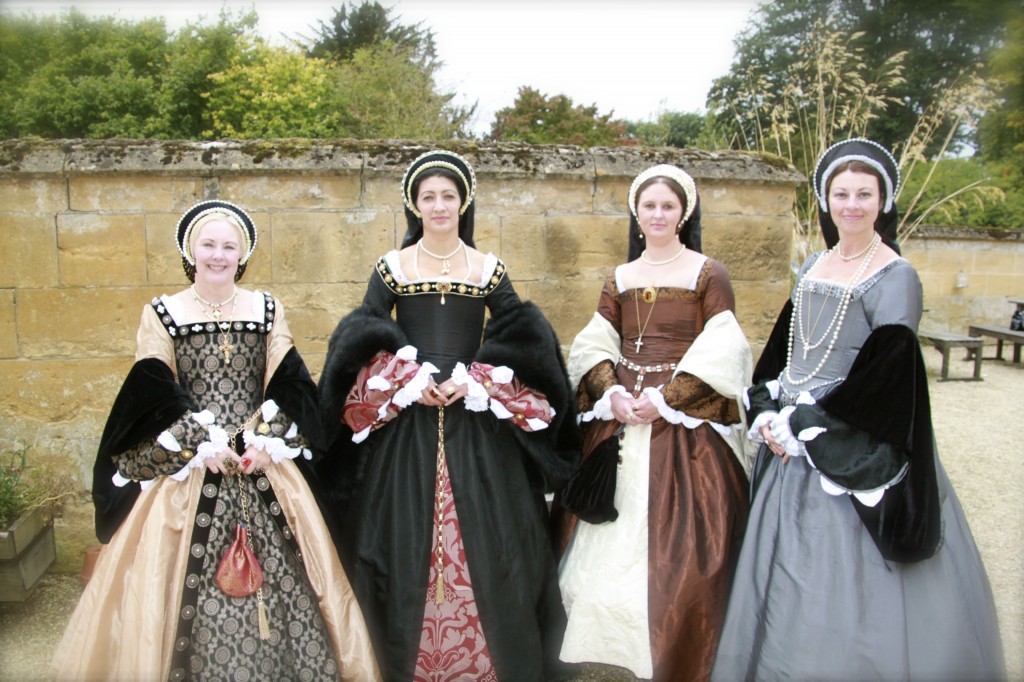
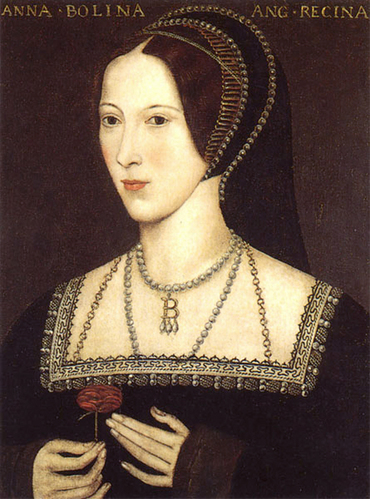
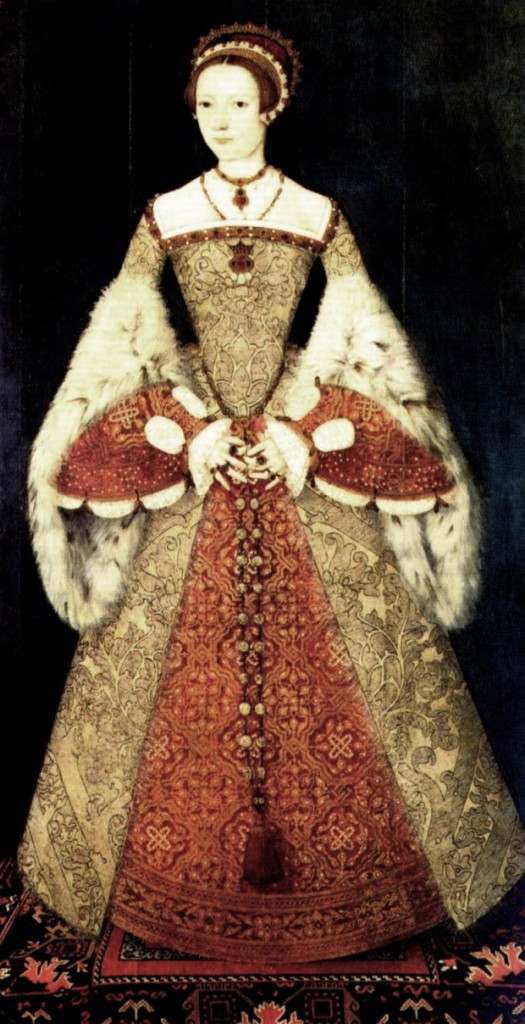

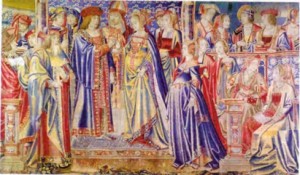







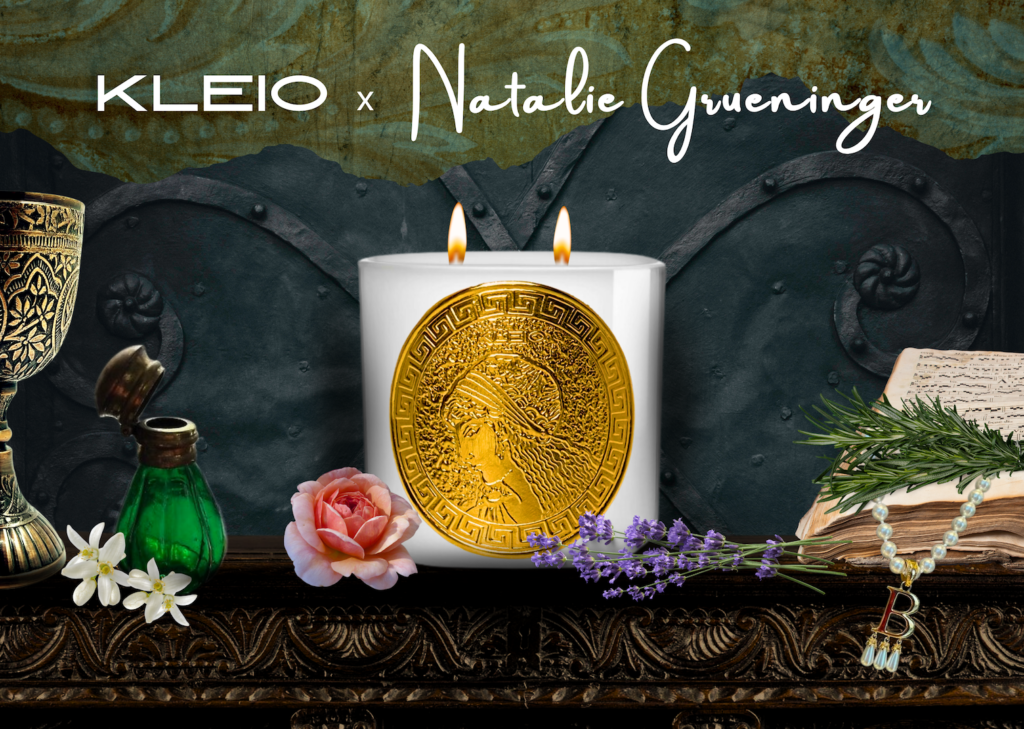













Fantastic article.
I have always been in love with the style of Tudor Gowns, as well as the people, since seeing the BBC series in 1970 as a 13 year old.
I once made a little Tudor gown for my friends little girl for a fancy dress parade for the Queens silver jubilee. I did it without a pattern, but it did turn out alright, though the materials used would not have been anything a person from that age would have recognised, lol..it was left over bits and bobs, old clothes, sheeting, and the likes….she got 2nd prize.
Now for decades I have been saying I am going to make a proper one, for an adult (me, really). I do have a pattern for guidance as well as the book the Tudor Tailor, so before I take the plunge, at last, I would be interested to know where I can source suitable materials for a gown of this type, and more importantly, at an affordable price based on the average pocket. Could you help Zarrina, it would be much appreciated.
Your gowns are spectacular, straight off the pages of a history book. Wonderful.
I am interested in the Tudor era because I am also a dolls house enthusiast and want to get authenticity to my house, dolls, clothes and furniture, and way of life.
Hi Norma, did you know that on eBay at the minute there are some miniature dolls patterns to dress your dolls house dolls in Tudor costume.
This article is great! I can’t wait to get my own Tudor pattern, it’s supposed to come today!!!
Is it possible for me to reproduce this article in a newsletter, full credit would be given of course.
Hello Donna, as I did not write this article I cannot give you permission to publish it in your newsletter. However, I recommend that you contact the author of this piece, Zarrina Bull via her website. Here is the link: https://www.tudorgowns.co.uk/. Very best wishes, Natalie.